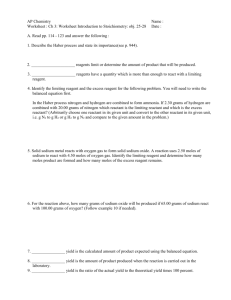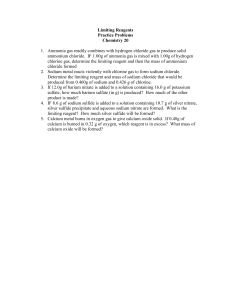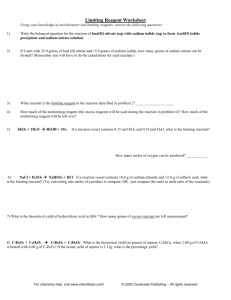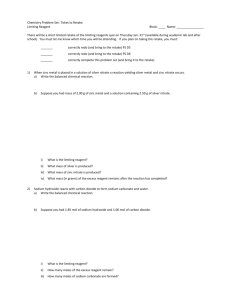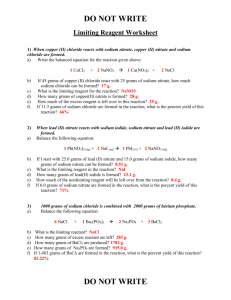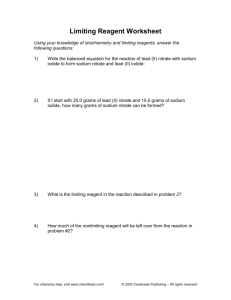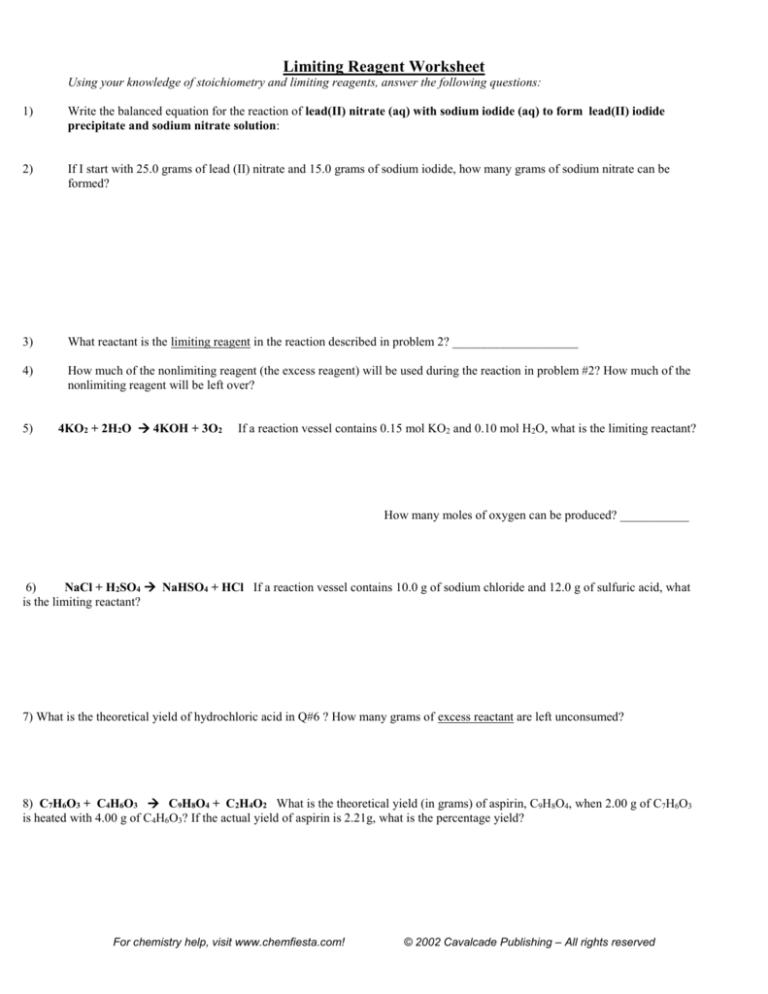
Limiting Reagent Worksheet
Using your knowledge of stoichiometry and limiting reagents, answer the following questions:
1)
Write the balanced equation for the reaction of lead(II) nitrate (aq) with sodium iodide (aq) to form lead(II) iodide
precipitate and sodium nitrate solution:
2)
If I start with 25.0 grams of lead (II) nitrate and 15.0 grams of sodium iodide, how many grams of sodium nitrate can be
formed?
3)
What reactant is the limiting reagent in the reaction described in problem 2? ____________________
4)
How much of the nonlimiting reagent (the excess reagent) will be used during the reaction in problem #2? How much of the
nonlimiting reagent will be left over?
5)
4KO2 + 2H2O 4KOH + 3O2
If a reaction vessel contains 0.15 mol KO2 and 0.10 mol H2O, what is the limiting reactant?
How many moles of oxygen can be produced? ___________
6)
NaCl + H2SO4 NaHSO4 + HCl If a reaction vessel contains 10.0 g of sodium chloride and 12.0 g of sulfuric acid, what
is the limiting reactant?
7) What is the theoretical yield of hydrochloric acid in Q#6 ? How many grams of excess reactant are left unconsumed?
8) C7H6O3 + C4H6O3 C9H8O4 + C2H4O2 What is the theoretical yield (in grams) of aspirin, C9H8O4, when 2.00 g of C7H6O3
is heated with 4.00 g of C4H6O3? If the actual yield of aspirin is 2.21g, what is the percentage yield?
For chemistry help, visit www.chemfiesta.com!
© 2002 Cavalcade Publishing – All rights reserved
Limiting Reagent Worksheet - Solutions
Using your knowledge of stoichiometry and limiting reagents, answer the following questions:
1)
Write the balanced equation for the reaction of lead (II) nitrate with sodium iodide to form sodium nitrate and lead (II) iodide:
Pb(NO3)2 (aq) + 2 NaI (aq) PbI2 (s) + 2 NaNO3 (aq)
2)
If I start with 25.0 grams of lead (II) nitrate and 15.0 grams of sodium iodide, how many grams of sodium nitrate can be
formed?
To solve, the students should do two calculations. In the first, they’ll determine the quantity of sodium nitrate that
can be formed with 25 grams of lead (II) nitrate, assuming that there’s plenty of sodium iodide present to react with it
– their calculation should indicate that 12.8 grams of sodium nitrate can be formed.
Likewise, they should do a calculation in which they determine the quantity of sodium nitrate that can be formed with
15 grams of sodium iodide. Their calculation should find that 8.51 grams of sodium nitrate can be formed.
Since the smallest of the two answers is 8.51 grams, this is the quantity of sodium nitrate that will actually be formed
in this reaction.
3)
What is the limiting reagent in the reaction described in problem 2?
Because sodium iodide is the reagent that causes 8.51 grams of sodium nitrate to be formed, it is the limiting reagent.
4)
How much of the nonlimiting reagent will be left over from the reaction in problem #2?
By doing a stoichiometry calculation to determine the amount of lead (II) nitrate required to form 8.51 grams of
sodium nitrate, students should determine that there are 8.38 grams of lead (II) nitrate remaining.
5.
Limiting reactant: KO2
Oxygen Produced: 0.11 moles
6.
Limiting reactant: H2SO4
7.
HCl Theoretical Yield: 4.4 g
Excess NaCl: 3.0 g
8.
Theoretical Yield: C7H6O3
Percentage Yield: 85%
Some problems Taken from: MGCCC, Perk Learning Lab, Created by Tara L. Moore
An Example Problem to do:
3TiO2 + 4C + 6Cl2 3TiCl4 + 2CO2 + 2CO
A vessel contains 4.15 g TiO2, 5.67g C, 6.78 g Cl2, what is the limiting reactant and the theoretical yield of
titanium tetrachloride?
Ex:
Limiting Reactant: Cl2
TiCl4 Produced: 9.07 g
For chemistry help, visit www.chemfiesta.com!
© 2002 Cavalcade Publishing – All rights reserved


